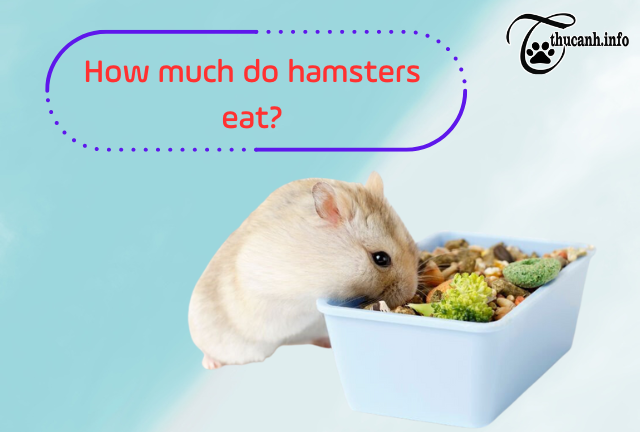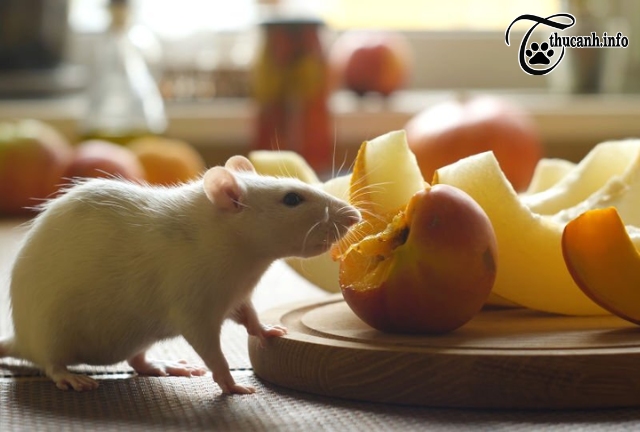Are you curious about the eating habits of hamsters? Wondering how much do hamsters eat? Look no further! In this comprehensive guide, we delve into the world of hamster nutrition, exploring their dietary needs and portion sizes. Discover the ideal balance of food, from pellets to fresh fruits and vegetables, seeds and nuts, and protein sources. Get ready to provide your furry friend with a healthy and satisfying diet!
1. How much do hamsters eat?
Wondering how much do hamsters eat? Hamsters have varying food intake depending on their size, age, and activity level. Typically, a hamster will consume around 2 tablespoons of food mix per day, while smaller hamsters may only need about 1 tablespoon.
It’s crucial to monitor their weight and adjust portions accordingly to prevent overfeeding or underfeeding. Providing a balanced diet of commercial hamster pellets, fresh fruits, vegetables, seeds, and nuts is essential for their nutritional needs. Consulting a veterinarian can help ensure that you are meeting your hamster’s specific dietary requirements.
2. Understanding the Dietary Needs of Hamsters
Hamsters have specific dietary needs that must be met to ensure their health and well-being. One key aspect is understanding how much they eat to provide them with the right amount of food.
2.1 Factors Influencing Hamsters’ Food Consumption
Several factors influence the amount of food hamsters eat. These include their size, age, and activity level. It’s important to consider these factors when determining their food portions.
2.2 Recommended Food Intake for Hamsters
On average, a hamster will consume approximately 2 tablespoons of food mix per day. However, smaller hamsters, such as Dwarf varieties, may require only about 1 tablespoon. Monitoring their weight and adjusting portions accordingly is crucial to avoid overfeeding or underfeeding.
2.3 Providing a Balanced Diet
To meet the nutritional needs of hamsters, it’s essential to provide them with a balanced diet. Commercial hamster pellets serve as a foundation for their diet, ensuring they receive essential vitamins and minerals. Supplementing their diet with fresh fruits, vegetables, seeds, and nuts adds variety and additional nutrients.
2.4 Consulting a Veterinarian
Each hamster is unique, and their dietary requirements may vary. Consulting a veterinarian knowledgeable in small animal care can provide valuable guidance in determining the appropriate food portions and ensuring a well-balanced diet. They can offer tailored recommendations based on the specific needs of your hamster.
By understanding the dietary needs of hamsters and monitoring their food intake, you can help promote their overall health and ensure they receive the proper nutrition for a happy and thriving life.
3. What Do Hamsters Eat?

Hamster Feeding Habits: How Much Do They Eat?
Wondering how much do hamsters eat? Hamsters have specific dietary requirements that need to be met in order to keep them healthy and thriving. Understanding what hamsters eat is essential to provide them with a well-balanced diet.
3.1 Commercial Hamster Food Pellets
Commercial hamster food pellets are an important part of a hamster’s diet. These pellets are specially formulated to provide the necessary nutrients, vitamins, and minerals that hamsters need. They offer a balanced mix of ingredients and are designed to meet their specific dietary requirements. It is recommended to choose high-quality pellets to ensure the best nutrition for your hamster.
3.2 Fresh Fruits and Vegetables
In addition to commercial pellets, fresh fruits and vegetables play a vital role in a hamster’s diet. These provide important vitamins, minerals, and fiber. It is important to offer a variety of fruits and vegetables to ensure a diverse nutrient intake. However, it’s crucial to avoid giving them toxic or harmful foods such as citrus fruits, onions, or garlic.
3.3 Seeds and Nuts
Seeds and nuts are another essential component of a hamster’s diet. These provide healthy fats, proteins, and additional nutrients. Hamsters enjoy a variety of seeds and nuts, including sunflower seeds, pumpkin seeds, and flax seeds. However, moderation is key when feeding them, as seeds and nuts are high in fat.
3.4 Grains and Whole Foods
Grains and whole foods, such as cooked brown rice, oats, and whole-wheat pasta, can also be included in a hamster’s diet. These provide carbohydrates, fiber, and some essential nutrients. Offering a small amount of these foods can add variety to their diet and mimic their natural foraging behavior.
3.5 Protein Sources
Protein is an important component of a hamster’s diet, as it supports their growth and overall health. Good sources of protein for hamsters include cooked chicken, hard-boiled eggs, mealworms, and crickets. These protein sources should be offered in moderation and as part of a balanced diet.
By providing a combination of commercial hamster food pellets, fresh fruits and vegetables, seeds and nuts, grains and whole foods, and appropriate protein sources, you can ensure that your hamster receives a well-rounded and nutritious diet. Remember to always consult a veterinarian for specific dietary recommendations tailored to your hamster’s needs.
4. Determining the Right Portion Size for Your Hamster
Wondering how much do hamsters eat? Providing the appropriate portion size is crucial to ensure that your hamster receives adequate nutrition without overeating. Several factors come into play when determining the right amount of food for your hamster.
4.1 Factors Influencing Hamster’s Food Intake
- The age and size of the hamster are key factors in determining their food intake. Younger and smaller hamsters generally require less food compared to adult and larger hamsters. It is important to consider their growth stage and adjust portion sizes accordingly.
- The activity level and energy requirements of your hamster also impact their food intake. Highly active hamsters, such as those with access to exercise wheels or engaged in frequent play, may require slightly larger portions to meet their increased energy needs.
- Pregnant and nursing hamsters have higher nutritional demands. During these stages, they need additional calories and nutrients to support themselves and their offspring. Consult with a veterinarian to ensure you provide the appropriate amount of food to meet their specific needs.

The Truth Revealed: How Much Food Do Hamsters Really Need?
4.2 How Much Food Should You Feed Your Hamster?
It is essential to follow general guidelines for daily food intake to prevent overfeeding or underfeeding your hamster. The specific portion size may vary depending on the individual hamster’s needs and dietary preferences.
- General Guidelines for Daily Food Intake: On average, a hamster will eat around 2 tablespoons of food mix per day. However, smaller hamsters, such as Dwarf varieties, may only need approximately 1 tablespoon per day. These guidelines provide a starting point, but it’s crucial to monitor your hamster’s weight and adjust the portion size as needed.
- Adjusting Portion Sizes for Different Hamster Sizes: As hamsters come in various sizes, it’s important to consider their individual needs. Larger hamsters, such as Syrians, may require slightly larger portions compared to smaller breeds. Carefully observe your hamster’s eating habits and body condition to determine if the portion size is appropriate for their size.
- Monitoring Weight and Adjusting Food Intake: Regularly monitor your hamster’s weight to ensure they maintain a healthy body condition. If your hamster is gaining weight excessively or becoming overweight, it may indicate overfeeding. Conversely, if they are losing weight or appear too thin, it may be necessary to increase their food intake. Adjust the portion size accordingly to maintain a healthy weight for your hamster.
By considering factors such as age, size, activity level, and monitoring weight, you can determine the right portion size for your hamster and ensure they receive the appropriate amount of food for their specific needs. Remember to consult with a veterinarian for personalized guidance based on your hamster’s unique characteristics.
5. Feeding Tips for a Healthy Hamster Diet
A balanced diet is crucial for maintaining the health and well-being of your hamster. By providing a variety of food types, avoiding high-sugar and fatty foods, and incorporating fresh treats and supplements, you can ensure that your hamster receives a nutritious and wholesome diet.
5.1 Providing a Balanced Diet
Offering a Variety of Food Types is essential to meet your hamster’s nutritional needs. Include commercial hamster food pellets as the foundation of their diet. These pellets are specially formulated to provide the necessary vitamins, minerals, and nutrients.
- Additionally, incorporate a variety of fresh fruits and vegetables, seeds and nuts, grains and whole foods, and protein sources. This diverse range of foods ensures that your hamster receives a well-rounded and balanced diet.
- Avoiding High-Sugar and Fatty Foods is crucial to prevent health issues such as obesity, diabetes, and dental problems. Limit sugary treats, including candies, sugary fruits, and processed foods.
- Similarly, minimize fatty foods like fried or greasy snacks. Instead, focus on providing nutritious and low-sugar options to promote optimal health.
Incorporating Fresh Treats and Supplements adds variety and enjoyment to your hamster’s diet. Offer occasional fresh treats like small pieces of fruits or vegetables. These treats not only provide additional nutrients but also stimulate your hamster’s natural foraging behavior. However, ensure that the treats are safe and suitable for hamsters.
5.2 Feeding Schedule and Hygiene
Establishing a proper feeding schedule helps maintain consistency and ensures that your hamster receives adequate nutrition. Provide fresh food once a day, preferably in the evening when hamsters are most active. This allows them to eat throughout the night, aligning with their natural feeding patterns. However, monitor your hamster’s food intake to prevent overeating or food waste.
Cleaning and Removing Uneaten Food is essential for maintaining a hygienic environment for your hamster. Hamsters may store excess food, leading to potential mold or spoilage. Regularly inspect the cage and remove any uneaten or spoiled food to prevent health issues. Clean food dishes and water bottles regularly to maintain cleanliness and prevent bacterial growth.
6. Signs of Overfeeding or Underfeeding
Hamsters have specific dietary needs, and it’s important to ensure they are neither overfed nor underfed. Monitoring their food intake and observing signs of overfeeding or underfeeding is crucial for their overall health and well-being.

Unveiling the Mystery: How Much Do Hamsters Eat?
6.1 Monitoring Your Hamster’s Health and Weight
Regularly monitoring your hamster’s health and weight is essential to ensure they are receiving the proper amount of food. Here are key indicators to watch out for:
- Weight Gain or Loss: Keep an eye on your hamster’s weight. Sudden weight gain could be a sign of overfeeding, while weight loss may indicate underfeeding. It’s important to maintain a healthy weight range for your hamster to prevent obesity or malnutrition.
- Abnormal Eating Patterns: Observe your hamster’s eating habits. If they consistently leave food behind or show disinterest in eating, it could be a sign of overfeeding. On the other hand, excessive scavenging for food or constant hunger may indicate underfeeding.
6.2 Consulting a Veterinarian
If you notice any concerning signs of overfeeding or underfeeding in your hamster, it’s recommended to consult a veterinarian who specializes in small animals. They can assess your hamster’s overall health, provide guidance on proper feeding practices, and address any specific concerns you may have.
Remember, maintaining a balanced diet and monitoring your hamster’s food intake are essential for their health and well-being. By being attentive to signs of overfeeding or underfeeding, you can ensure that your hamster is receiving the appropriate amount of food to thrive.
7. FAQs
7.1 How much should I feed my dwarf hamster
Wondering how much do hamsters eat? The amount of food to feed a dwarf hamster depends on various factors such as its weight, age, and activity level. In general, a dwarf hamster should be fed around 1-2 tablespoons of food per day. It’s important to monitor their food intake and adjust portions accordingly to prevent overfeeding or underfeeding.
By providing a balanced diet and observing your dwarf hamster’s eating patterns and weight, you can ensure they are receiving the appropriate amount of food for their overall health and well-being.
7.2 How much food should a hamster eat a day?
The daily food intake of a hamster varies based on its size, age, and activity level. On average, a hamster should consume approximately 1-2 tablespoons of food per day. It’s crucial to monitor their eating habits and adjust the portion size accordingly to prevent overfeeding or underfeeding.
Providing a balanced diet consisting of commercial hamster pellets, fresh fruits and vegetables, seeds and nuts, grains, and protein sources will ensure they receive the necessary nutrients. By observing their food intake and maintaining a healthy weight, you can ensure your hamster’s overall well-being.
7.3 Can I feed my hamster everyday?
Yes, it is essential to feed your hamster every day to meet their nutritional needs. However, the key is to provide the appropriate amount of food to prevent overfeeding. The daily food intake for a hamster typically ranges from 1-2 tablespoons, depending on their size and activity level.
It is crucial to monitor their food intake and adjust the portion size accordingly. Providing a balanced diet with commercial hamster pellets, fresh fruits and vegetables, seeds, nuts, grains, and protein sources will ensure they receive the necessary nutrients. By maintaining a consistent feeding schedule and monitoring their weight, you can ensure your hamster’s overall health and well-being.
7.4 Can you feed a hamster too much?
Yes, it is possible to overfeed a hamster. Feeding them excessive amounts of food can lead to obesity and various health issues. It is important to provide the right portion size based on their dietary needs. Hamsters typically eat around 1-2 tablespoons of food per day, but this can vary depending on their size, age, and activity level.
Monitoring their weight and adjusting their food intake accordingly is crucial to maintain their optimal health. By providing a balanced diet and avoiding excessive treats or high-calorie foods, you can ensure that your hamster maintains a healthy weight and overall well-being.
7.5 How Much does hamster food cost
The cost of hamster food can vary depending on the brand, quantity, and quality of the food. On average, a bag of hamster food can range from $5 to $20. However, it is important to note that the cost of hamster food is a small expense compared to the overall care of a hamster.
The primary focus should be on providing a balanced and nutritious diet rather than solely considering the cost. By choosing a high-quality hamster food that meets their dietary needs and supplementing it with fresh fruits, vegetables, and occasional treats, you can ensure your hamster’s health and well-being.
8. Conclusion
In short, the article on thucanh.info has helped you understand how much hamsters eat. By providing a balanced diet and monitoring their food intake, you can ensure that your hamster is getting the right amount of nutrition. Remember to consider their age, size, and activity level when determining portion sizes. Regularly observe their weight and eating habits to identify any potential problems. By following these guidelines, you can keep your hamster happy, healthy, and satisfied.


